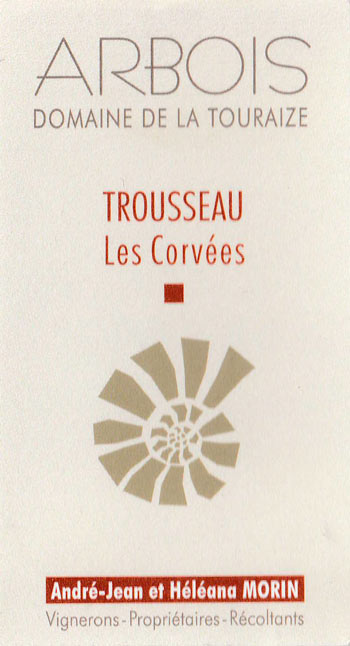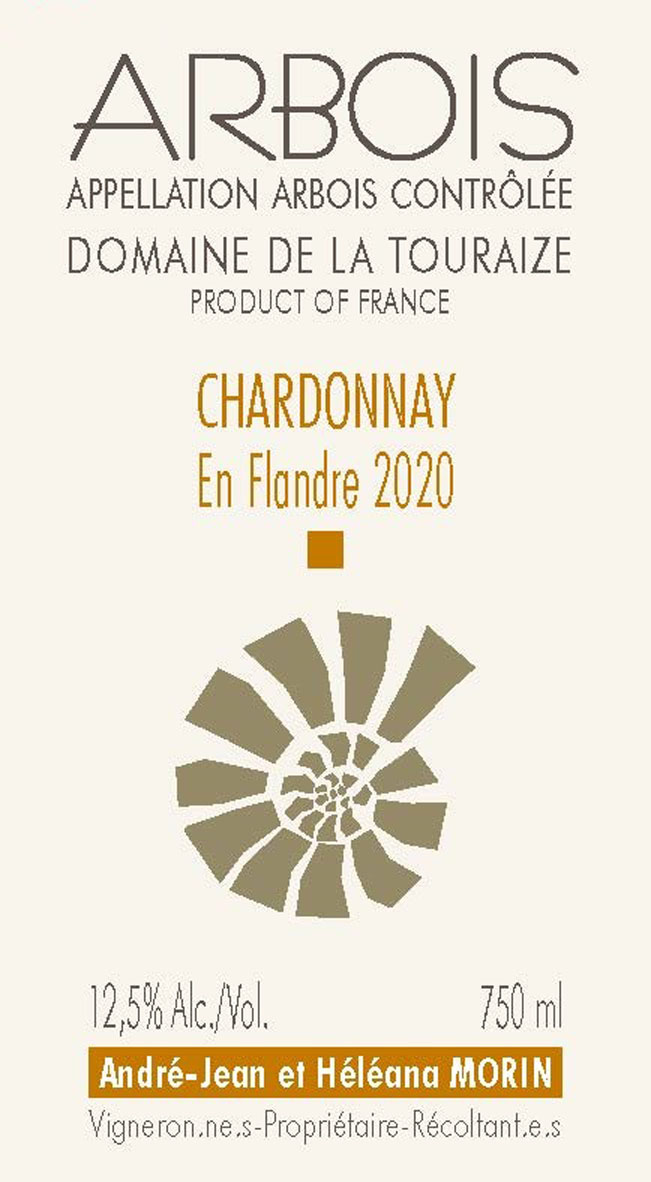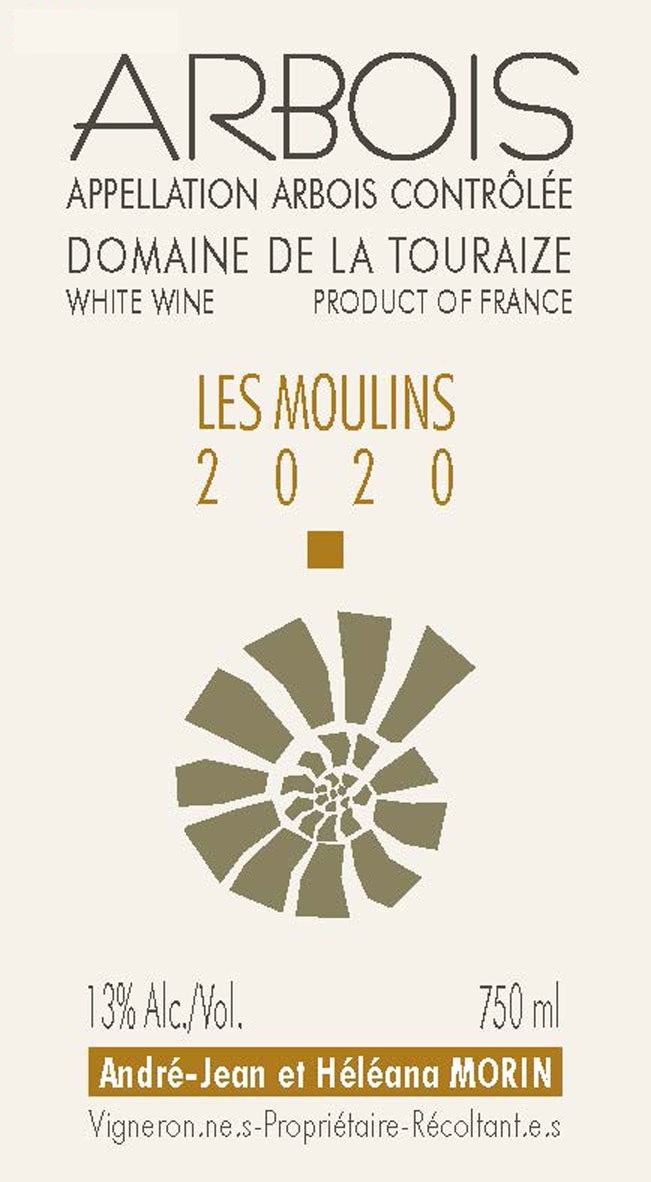
Domaine de la Touraize
Wines

Arbois
Arbois Ploussard “La Cabane”
“La Cabane” (“the shack”) comes from 1.2-ha. of Ploussard in two parcels: the blue marl of Curoulet planted in the early 1980s, and the grey marl of La Touraize planted in the early 1960s. The bunches are hand-harvested and also painstakingly de-stemmed by hand. The fruit is transferred by gravity to stainless steel, where it macerates semi-carbonically for two weeks before pressing, and the wine spends six months in large used barrels before being bottled without filtration, and with just 10-mg/L of added sulfur. Remarkably pure-fruited and ethereal, “La Cabane” clocks in under 12% alcohol (A-J never chaptalizes) yet expresses immense mineral depth. In its gorgeous translucent hue, its soaring aromas of citrus zest and red apples, and its light yet persistent palate, it embodies the uniqueness of this beloved indigenous variety.
Arbois Trousseau “Les Corvées”
Domaine de la Touraize owns a 1.95-hectare parcel of Trousseau planted in 1972 in the southwest-exposed Les Corvées vineyard, whose warmth-retaining soils of gravel over marl are particularly suited to the variety. The bunches are manually harvested and lightly crushed, and fermentation occurs during a three-week maceration with occasional pump-overs and no punch-downs. This delicate extraction allows the fruit to remain lithe and supple, while still showing more color, weight, and depth than the Ploussard, as one would expect from the variety. Raised for one year in a combination of 80% large foudres and 20% terracotta jar, “Les Corvées” is chiseled, driving, and concentrated, built around kinetic energy rather than excessive structure.
Arbois Blanc, Chardonnay “Les Voisines”
“Les Voisines” (“the neighbors”) comes from 2.35 hectares of Chardonnay spread among four parcels in Arbois: Curoulet, En Flandre, Les Corvées, and La Platière, with soils ranging from gravelly marl to calcareous marl to blue marl. The fruit is pressed whole-cluster, undergoing alcoholic and malolactic fermentation in well-used barrels of varying sizes, where the wine spends 18 months on the fine lees and is bottled without fining or filtration, and with just 20-mg/L of sulfur added after malolactic finishes. The barrels are kept full, in the ouillé style, and the finished wine displays bristling minerality unaccented by oxidative elements. Despite its recognizable varietal character and its purity of fruit, however, this is a forcefully saline, chiseled iteration of Chardonnay that could be produced nowhere else but the Jura.
Arbois Blanc, Chardonnay “Ammonites”
Named after the extinct cephalopodic mollusk whose fossilized shells are found throughout the Jura’s distinctive soils, Touraize’s “Ammonites” comes from 0.8 hectares worth of Chardonnay in the gravelly marl of the vineyards Curoulet and La Platière, planted between the early 1960s and the early 1980s. These more marl-heavy soils make for a richer, broader wine than one born of limestone, and this offering—fermented and aged two years in used 600-liter barrels which are kept full—displays a dynamic combination of exotic fruit (pineapple, mango) and vigorous acidity, atop a palate simultaneously unctuous and bone-dry.
Arbois Blanc, Chardonnay, “En Flandre”
The En Flandre parcel takes its name from the region of Flanders, which—like the Jura—was part of the kingdom of Spain during the rule of the Habsburgs, and which bears a similar landscape to that of the Jura. Domaine de la Touraize produces a single-vineyard Chardonnay from its limestone-rich soils, aged for two winters in used 600-liter barrels which are kept topped-up, and bottled without fining or filtration, and with a mere 20 milligrams per liter of sulfur. This is a wine of palate-staining, seashell-like minerality, with unapologetically intense acidity and a salty-sweet interplay on the palate that leaves one salivating in amazement.
Arbois Blanc, “Les Moulins”
Les Moulins is a southwest-facing vineyard of grey-blue marl situated at 350 meters altitude, and Touraize owns a 0.75-hectare parcel of co-planted Chardonnay (two-thirds) and Savagnin (one-third) there, planted between the late 1950s and the late 1990s. After whole-cluster pressing, the juice is blended and co-fermented in 20-hectoliter casks, where it spends 18 months on the fine lees with regular topping-up. As with the Chardonnay “Ammonites,” the marl soils here lend “Les Moulins” breadth and power, with the Savagnin contributing notes of spice to the dominant flavors of peach and apricot. Given the richness with which the wine enters the mouth, its finish is surprisingly tense and long, suggesting years of potential evolution in bottle.
Arbois Blanc, “Zeste de Savagnin”
A-J began his “Zeste” project by happy accident; a batch of 2018 Chardonnay had elevated volatile acidity in barrel, so he added some skins upon which a younger wine had just finished fermenting, and the wine corrected itself. He loved the results, and began producing a Savagnin which employs skin-contact but which A-J adamantly resists classifying as an “orange wine.” The Savagnin for this bottling is destemmed by hand via crible (his other whites are pressed whole-cluster) and undergoes semi-carbonic maceration with no pump-overs or punch-downs. It then spends two winters in a single 12-hl terracotta jar on its fine lees, and is bottled without fining or filtration. Showing salty grip on the palate but without overt tannins, “Zeste de Savagnin” is explosively spicy, with notes of poached pears on an impressively concentrated palate.
Arbois Blanc, Savagnin, “Sous Voile”
Only a small portion of Touraize’s output is in the classic oxidative style, but A-J’s touch with sous-voile wine is masterful—of a piece with his topped-up whites and his reds in its emphasis on purity and precision. From a hectare of early-1990s Savagnin planted in the grey-blue marl of the northwest-facing Petit Curoulet vineyard, this wine spends 30 months with no topping up in used 228-liter barrels in an attic above the winery, whose temperature fluctuations promote the development of the yeast veil. Petit Curoulet is a very cold site which produces fruit of remarkable acidity: an ideal scenario for oxidative Savagnin, as it provides a spine around which the complex and unusual flavors are anchored. Here, notes of marzipan, salt, and green apples frame an ebullient palate marked but not dominated by oxidation.
Arbois Vin Jaune
From the same hectare of northwest-exposed Savagnin in Petit Curoulet as the Savagnin “Sous Voile,” Touraize’s Vin Jaune is produced in painfully small quantities—between 700 and 1000 bottles per vintage. Aged the requisite six years and three months in used 228-liter barrels in the winery’s attic, it comes across as fresh and lifted despite the panoply of natural-veil-derived oxidative flavors, with deep yellow fruits commingling with notes of fresh leather, pink salt, and candied almonds. It is rare to find a Vin Jaune so precise and refreshing as this, but it fits beautifully alongside the rest of A-J’s lineup stylistically.










